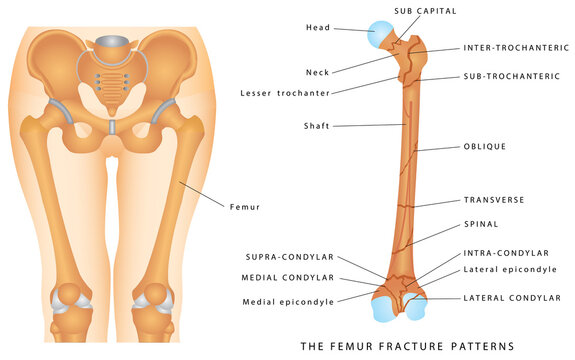Femur bone: The longest bone in the human body

The total bone count of an adult body is 206. These 206 bones come in different shapes and sizes and have specific functions depending on the location. In this article, we will cover the longest bone of the human body, which is the femur bone. The Femur bone is the longest and strongest bone of the human body. It is vital for standing, moving, and keeping body balance. Usually, femur bones are strong and are less prone to break. However, if your bones are weakened by osteoporosis, you’re more likely to face fractures, even from minor incidents.
Femur bone:
The bones of the leg comprise the femur, tibia, and fibula. The femur forms the upper leg while the tibia and fibula form the lower portion of the leg. Your thigh bone is called the femur. It is one of the strongest and longest bones in the human body. The femur plays an important role, by maintaining the body’s stability along with its movement.
Location of femur
The Femur bone extends from the hip to the knee and is commonly known as the thigh bone. The femur also supports lots of important muscles, tendons, ligaments, and part of your circulatory system.
Structure of femur bone
The femur bone comprises a long shaft in the middle and two rounded ends. The proximal ends of the two shin bones (tibiae) and two thigh bones (femurs) join together as they move down towards the knees. The angle formed by the thigh bones as they come together mostly decides the femoral-thigh angle. Femora converge more in females than males because females have wider pelvic bones. Even though the femur is one of the longest bones of the human body, it is made of multiple parts. These include the following:
The upper part (proximal).
The body (shaft).
The lower part (Distal).
The upper part (proximal):
The upper (proximal) end of your femur connects to your hip joint. The proximal end consists of the following: The neck, The head, and The trochanters.
The neck is a narrow area that holds the head in place and joins it to the femur’s shaft. The greater trochanter, which resembles a broad flat surface, is located on the lateral side of the proximal femur. The lesser trochanter, which resembles a smaller surface, is located on the median side of the bone immediately below the neck.
The body (shaft):
The shaft of the femur comprises the majority of the bone. It is a long, straight section that extends from end to end. The shaft of the femur includes the following:
Linea Aspera
Gluteal tuberosity
Pectineal line
The lower part (Distal):
The distal end of the femur, which is the lower portion of the femur, forms the top of the knee joint. It encapsulates the tibia and knee bone in the lower leg. The lower part of the femur includes the following:
Medial and lateral condyles
Medial and lateral epicondyles
Intercondylar fossa
Conditions and Disorders:
The most common issues that affect femurs are fractures, osteoporosis, and patellofemoral pain syndrome.
Femur fracture: The Femur bone is the strongest bone of the human body and doesn’t break easily, but serious accidents can lead to a broken thighbone, which is known as a femur fracture.
Types of femur fracture:
Proximal femur fracture: Involves the upper portion of the bone next to the hip joint.
Femoral shaft fracture: Involves the middle portion of the bone and is usually a very severe injury.
Supracondylar femur fracture: involves the area just above the knee and is considered uncommon.
Osteoporosis: Osteoporosis causes bones to become weak, thus making them prone to breakage and injury.
Patellofemoral pain syndrome: It is a broad term used to describe pain in the front of the knee and around the patella or kneecap.
Femur test and treatments:
You don’t need treatment until you face severe pain or fracture, but if confirmed with the conditions or disorders mentioned above, your clinical provider may use a splinter cast in case of fracture or exercise, vitamin and mineral supplements in case of osteoporosis after performing a few tests which include the following: X-raysMagnetic Resonance Imaging (MRI)CT scan
Conclusion:
The femur is the longest and strongest bone of the human body and plays a vital role in maintaining body balance, movement,
and stability. It is also known as the thigh bone and is hard to break. Femur bone can face breakage only if, you encounter a serious accident or sufferfrom osteoporosis.
Most asked questions:
Which is the smallest and longest bone in the human body?
The stapes bone is the smallest bone and the femur bone also known as the thighbone is the longest bone in the human body.
How big is the femur bone?
In most adults, femur bones are around 18 inches long.